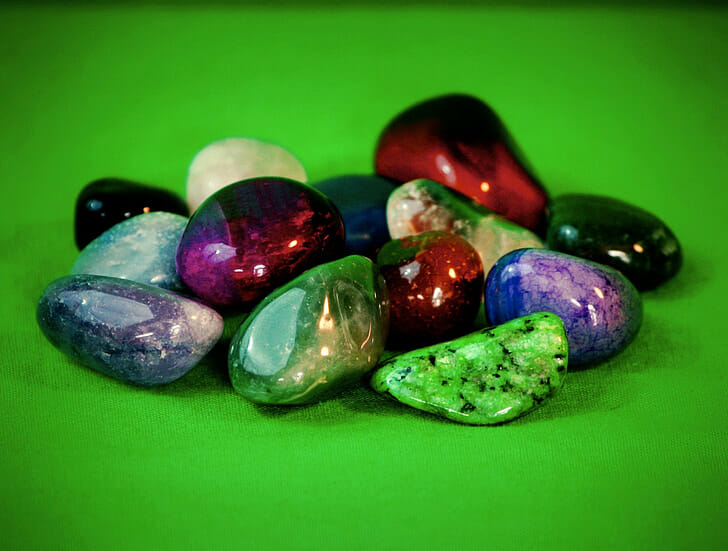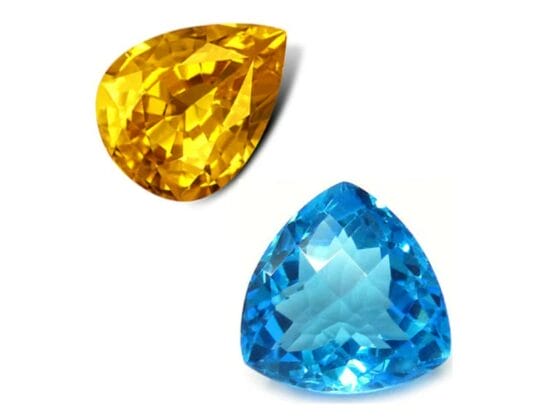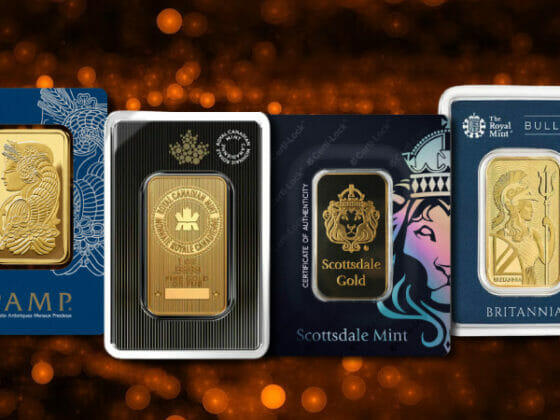If you’re looking for a fun and colorful introduction to the world of gemstones, a good place to start is exploring the idea of birthstones by month. It’s a popular topic that appeals to people of all ages, regardless of their gender, age, nationality, or religion.
It’s believed that certain gemstones carry special attributes, secrets, and lore. Countless legends and myths surround them.
Precious gemstones were first associated with signs of the zodiac and adored for their special meanings. In 1912, the Jewelers of America (JA) formulated a list that is commonly used today.
Some months have more than one birthstone and can vary according to historical or cultural traditions. So, read on, and let’s dive into the mesmerizing world of colorful birthstones by month.
Table of Contents
- 1 How Birthstones Originated
- 2 The Spiritual and Healing Properties of Birthstones
- 3 Birthstones by Month: Meaning and Symbolism
- 3.1 January Birthstone: Garnet
- 3.2 February Birthstone: Amethyst
- 3.3 March Birthstone: Aquamarine
- 3.4 April Birthstone: Diamond
- 3.5 May Birthstone: Emerald
- 3.6 June Birthstone: Pearl & Alexandrite
- 3.7 July Birthstone: Ruby
- 3.8 August Birthstone: Peridot & Spinel
- 3.9 September Birthstone: Sapphire
- 3.10 October Birthstone: Opal & Tourmaline
- 3.11 November Birthstone: Topaz & Citrine
- 3.12 December Birthstone: Turquoise, Zircon & Tanzanite
- 4 How to Choose and Care for Your Birthstone
- 5 Birthstones in Jewelry and Personal Accessories
- 6 The Enchanting World of Birthstones: FAQs
- 7 Conclusion
How Birthstones Originated
The tradition of birthstones goes back thousands of years to the Book of Exodus. According to the book, the first high priest of the Israelites wore a breastplate adorned with twelve stones.
These twelve stones were believed to have magical powers. They also represented the Twelve Tribes of Israel. At that time in history, it became a tradition for Christians to wear all twelve stones.
Over time, the tradition changed, and people rotated their collections, choosing to wear one stone at a time. They chose their stones based on which one was the most powerful at that time. Eventually, this evolved to associating certain gemstones with birth months.
As well as this Christian tradition, other ancient cultures revered gemstones, connecting them to their calendar systems. For example, Vedic astrologers recommended specific gemstones based on a person’s astrological chart. Hindu texts connect certain stones to different planets and days of the week.
Modern Adoption of Birthstones

In 1912, an official list was created in the United States. The National Association of Jewelers (now known as the Jewelers of America), created the standardized list.
The gemstones were chosen based on tradition, but that wasn’t all. They were also picked based on whether American jewelers could realistically sell the stones.
Since its creation, the “official” list has undergone some changes. This is why you’ll find different birthstones depending on where you’re looking.
The Spiritual and Healing Properties of Birthstones

Image by: Huffington Post UK
People celebrated birthstones for their beauty and rarity but are also considered to possess spiritual properties and have symbolism associated with them.
Many believe each birthstone has unique spiritual energy and properties that promote balance, protection, and healing.
We can trace back the idea of using birthstones for spiritual purposes to ancient civilizations. Folks believed they possessed magical powers and often used them in spiritual practices.
Even today, birthstones hold a special place in many cultures. You’ll typically find them used to enhance spiritual energy and connect to the divine. The Greeks and Romans, for example, believed that each gemstone had special powers that could influence the course of a person’s life.
Birthstones by Month: Meaning and Symbolism
Discover what makes each birthstone special in the following list.
January Birthstone: Garnet

Image by Gemstones
Garnet is a gemstone that’s credited with the power of protection from snake bites and nightmares. It is also believed to guide in the dark. The word “garnet” derives from a term that means “seed”. This is because the gem is a similar color and shape to a pomegranate seed.
Traditionally, garnet is connected with blood. It is also a popular gift for second wedding anniversaries.
The garnet gemstone is mentioned in history as far back as Roman, Italian, Russian, Arabic, Hebrew, and old Hindu (Ayurvedic) calendars.
There are a variety of gemstones in the garnet gemstone group, such as star garnet, hessonite garnet, almandine garnet, color change garnet, and several more. While the January birthstone, garnet, is more commonly red, almost every other color is available.
February Birthstone: Amethyst

Image by Prisma Gems
Many believe the amethyst induces temperance, serenity, peace, and quick-wittedness in business. Ancient Greeks thought that the gemstone guarded against intoxication. The name comes from “methustos”, a Greek word that means “intoxicated.”
In addition, the February birthstone also supposedly protects anyone wearing it from deceit. Other attributes include preventing baldness and improving skin and hair.
The purple color of this crystalline quartz birthstone is linked to royalty, and it is often given as a sixth wedding anniversary gift.
Other birthstones for February include moonstone, pearl, and hyacinth (red zircon). You can instantly recognize Amethyst by its violet color. However, colors range from pale lilac to a deep reddish purple.
March Birthstone: Aquamarine

Image by Sena Gems
Aquamarine is the birthstone of March. Its rich sea-blue color has long been a symbol of hope, health, love, and youth. The name of this gemstone comes from the Latin for seawater, and ancient mariners claimed the gem calmed waves and kept them safe. They would wear aquamarine talismans etched with the sea god Neptune.
March’s birthstone was also thought to cure stomach, liver, and heart diseases. However, to benefit from the healing power of this blue variety of the mineral known as beryl, you had to soak the gem in water and then drink the water.
April Birthstone: Diamond
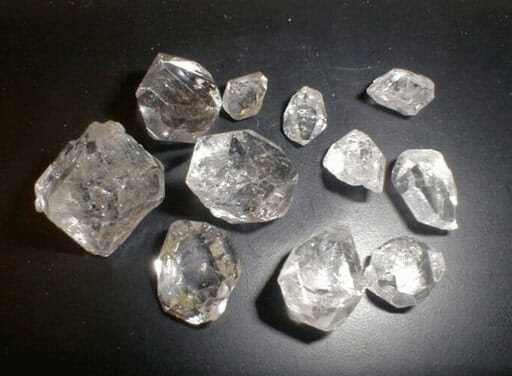
Image by The Diamond Authority
The king of gems is the birthstone for April. It is also the world’s most popular gem and one of the most expensive birthstones by month. The name diamond comes from the Greek word “Adamas”, which means invincible.
Over the years, it was thought to provide protection against the plague and be an antidote to poison, among other things. Some claim it increases happiness, beauty, strength, and longevity.
Our love for the birthstone of April started in India, where folks gathered it from streams and rivers. It was traded as far back as the fourth century BCE, and diamonds were coveted by royalty and the wealthy. Later, caravans brought Indian diamonds to Medieval Venetian markets.
By the 1400s, it had become a fashionable accessory for Europe’s upper class. In 1477, Archduke Maximillian of Austria gave the first recorded diamond engagement ring to Mary of Burgundy.
In the early 1700s, India’s diamond supplies started to dwindle, and Brazil emerged as the next important source. For more than 150 years, Brazil dominated the diamond market.
The beginning of the modern diamond market began with the discovery of diamonds near Kimberley, South Africa. An entrepreneur named Cecil Rhodes established De Beers Consolidated Mines Ltd in 1880. In less than 20 years, De Beers controlled around 90% of the world’s rough diamond production.
As well as being the birthstone for April, a diamond is a traditional gift of choice for 60th and 75th wedding anniversaries. It is also an almost universal symbol of love and marriage when set in an engagement ring.
May Birthstone: Emerald

Image by Jacobs the Jewellers
The birthstone for April is emerald. This beautiful and vibrant gemstone is a symbol of rebirth and love. Emeralds are also believed to have healing properties and heal illnesses such as malaria and cholera and ensure good health for anyone who wears one. Another special power is that it can help people see into the future when placed under the tongue.
Emeralds have been a prized stone for centuries, mostly because of their rarity and beauty. They are even said to have been worn by Cleopatra. She was known for having a passion for emeralds and using them in her royal adornments.
Inca emperors were also very fond of this stone. The legendary Crown of the Andes, fashioned in colonial South America, is a shining example of the reverence they paid to May’s birthstone.
Emerald is the green variety of the mineral beryl and can be found in a range of colors from yellowish green to slightly bluish green. The most popular and valuable are pure green emeralds.
Lab-grown emeralds have become a popular option because they cost a fraction of the cost of a natural emerald.
June Birthstone: Pearl & Alexandrite
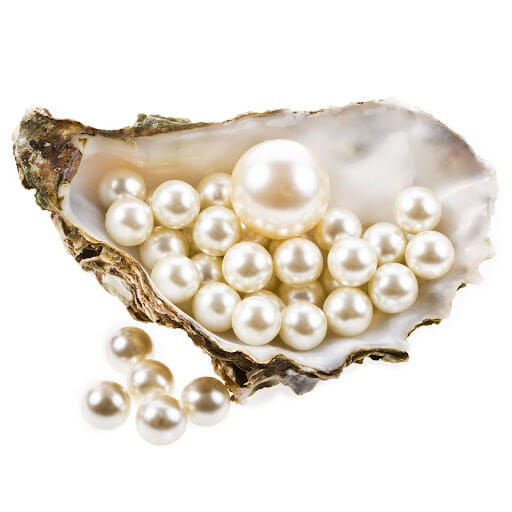
Image by The Pearls Source
The month of June is lucky enough to have two recognized birthstones: pearl and alexandrite.
Pearl is an enchanting birthstone found in rivers, lakes, and oceans around the world. It has become a timeless wardrobe staple, and women have been loving it for centuries.
Ancients from the Middle East believed that pearls were teardrops fallen from heaven, while the Chinese liked the idea of pearls coming from the brain of a dragon. Christopher Columbus and his peers believed mollusks formed their pearls from dew drops.
Cultured pearls, a product of human intervention, have mostly replaced natural pearls. They are raised in saltwater and freshwater pearl farms and account for most of pearl sales today.
We associate pearls with innocence, humility, and purity. They were also traditionally given as a wedding gift.
Alexandrite is a rare variety of the mineral chrysoberyl. A distinctive feature of this birthstone is that it changes color in different lighting. The most prized alexandrites are those that are a vivid green/blueish green in daylight or fluorescent light and, in incandescent light, change from an intense red to purplish red.

Image by Minerals
Another unusual phenomenon is the cat’s eye effect. It occurs when certain types of long, thin inclusions are orientated parallel to each other.
Alexandrite is worn to invite good luck and enhance intellect.
The name of this gemstone was given to it when major deposits were first discovered in Russia’s Ural Mountains in 1830. They were named after Alexander II, the heir apparent to the throne.
July Birthstone: Ruby

Image by Astroupay
Ruby is the birthstone of July and the world’s most popular red gem. The stones range in color from an orangy-red to slightly purplish red. The most desirable color is a deep red with a hint of purple, also known as “pigeon’s blood,” in the trade. The name of this gem derives from “Ruber”, the Latin word that means red.
Ruby is a variety of the mineral corundum. It gets its color from the element chromium which is present in trace amounts. Higher levels of chromium make the gem a stronger red.
Rubies have long been associated with strength and physicality. Warriors favored rubies and thought they were intricately connected with the human body.
In addition, people believed that the gemstones increase the stamina and strength of those who wear them. Other powers include the ability to bring calmness and help people work their way through passionate social situations.
August Birthstone: Peridot & Spinel

Image by Ward Gemstones
August is another month with two birthstones, the dual stones of sun and fire, peridot, and spinel.
Peridot is known for being formed under extreme conditions and carried from deep within the Earth’s mantle in lava. It has also been found in meteorites from outer space. It ranges in color from yellowish green to greenish yellow and throughout history, many commonly confused it with topaz and emerald.
The Shrine of the Three Holy Kings in Cologne Cathedral is a fine example of this confusion. The 200 carats of gems that decorate it were long considered to be emeralds but are peridot.
Peridot was valued in many medieval and ancient cultures. As early as the second century BCE, priests wore it in their jewelry. It has also been popular for centuries as a talisman that protects the owner from “terrors of the night” and evil spirits.
Spinel is a name that comes from the Latin word “spina”, meaning thorn. This refers to the shape of the crystals. It is found in a range of colors including orange, purple, blue, intense red, and vibrant pink. It’s another gemstone that’s been mistaken for other gemstones.

Image by Catawiki
One of the most famous examples is the red spinel set in Great Britain’s Imperial State Crown. It wasn’t until the 18th century that the 170 ct Black Prince’s “ruby” was recognized as a spinel based on its chemical difference.
Red spinel was thought to be a cure for various inflammatory diseases and blood loss. People also believed that it lessened anger and promoted harmony.
September Birthstone: Sapphire

Image by Haruni
The wearer of September’s birthstone will enjoy faith and purity, and it’s commonly believed that the brighter the glitter of the sapphire, the stronger the virtues. At the same time, it allows people to see into the future.
Sapphires were also a favorite stone of priests and kings. Clerics of the Middle Ages wore sapphires because they symbolized heaven. Ancient Persians believed the earth rested on a giant sapphire and was the reason the sky was blue.
Most people think of the color blue when it comes to sapphires, but it is found in many colors, including yellow, pink, orange, green, or purple.
The most famous sapphire in recent years is the 12-carat blue sapphire surrounded by diamonds in the engagement ring first worn by Princess Diana and then given by her son to Kate Middleton, now the Duchess of Cambridge.
October Birthstone: Opal & Tourmaline

Image by The Diamond Store
The dual birthstones for October are opal and tourmaline, both of which come in a rainbow of color combinations and shades. The color of tourmaline is dependent on trace elements in the gemstone’s makeup. Opal diffracts light and displays a multitude of colors.
Opals are individually distinctive gemstones. They are very delicate gemstones and require exceptional care. This October birthstone is often associated with magic and light, possibly because of its dynamic appearance.
People have also credited it with healing properties, particularly for the eyes. It’s also been known for people to believe it makes them invisible when they wear it.
Opals are the only gemstones that display a phenomenon called play-of-color. What this means is that the stone displays flashes of color when turned. However, not all opals have this quality.
Opals were first discovered in Australia around the 1850s and the country has been responsible for 95% of the world’s supply.
Tourmaline is a crystalline boron silicate mineral mixed with elements such as iron, sodium, potassium, lithium, or aluminum.
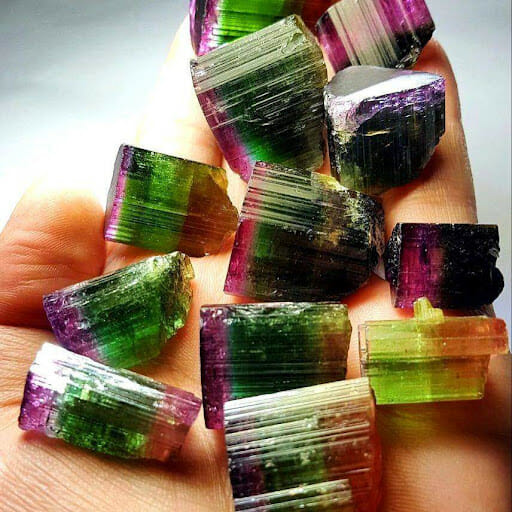
Image by Geology In
It’s these combinations that result in the gemstone’s multi-colors. It’s a stone that’s popular all over the world, with people alleging it has stress relieving and healing properties and boosting creativity.
November Birthstone: Topaz & Citrine
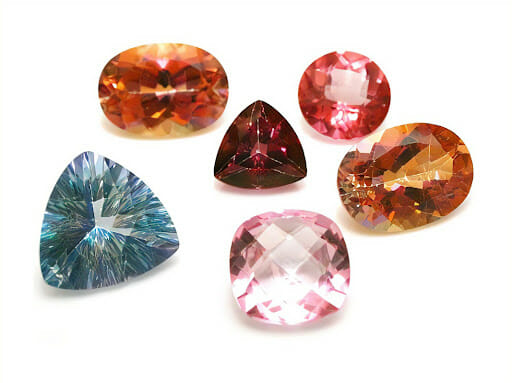
Image by Wikipedia
People born this month also get two gemstones to choose from, both sunny and bright to cheer wearers up on chilly November days. Topaz and citrine, the gorgeous November birthstones, might look remarkably similar and even be mistaken for each other, but they are unrelated minerals.
Topaz has traditionally been considered a yellow gemstone, but it’s available in various colors. Pure topaz is colorless, but impurities in the stone tint it, and it can take on any color of the rainbow.
During the Renaissance, people believed this birthstone could quell anger and break spells in Europe. Hindus believe a topaz pendant could bring longevity and wisdom. African shamans like to use topaz in their healing rituals and treat it as sacred.
Citrine is a variety of quartz that can range in color from a pale yellow to a honey orange. The stone’s yellow hue is caused by traces of iron in the quartz crystal.

Image by Geology Learn
In ancient times, folks believed citrine could soothe anger, manifest desires, and calm tempers. To harness these powers, the Egyptians made the gemstone into talismans, Roman priests made it into rings, and the ancient Greeks carved iconic images into them.
December Birthstone: Turquoise, Zircon & Tanzanite
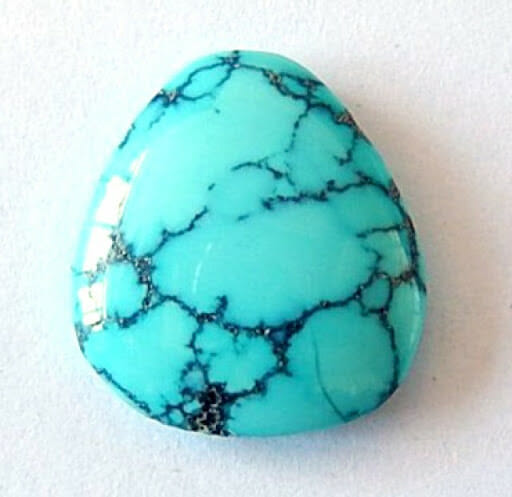
Image by Gem Rock Auctions
A trio of wintery blue stones are the birthstones for December: turquoise, zircon, and tanzanite. All these stones are inexpensive; however, their beauty easily matches more precious gemstones.
Turquoise is a gemstone that’s been admired for centuries, mainly for its distinctive color, which ranges from greenish robin egg blue to a more powdery blue. The traditional source of the sky-blue turquoise gemstones was Ancient Persia, now Iran. Nowadays, the US is the world’s largest supplier of the stone.
This gemstone has adorned a wide range of items, from weapons and bridles to ceremonial masks and jewelry. Kings and warriors, ancient Egyptians and Persians, Native Americans, and Aztecs have all admired this stone.
Often regarded as a love charm, it’s also believed to relax the mind, protect its wearer from harm, and symbolize success and good fortune.
Zircon is an often-underrated gem, commonly confused with synthetic cubic zirconia. It’s found in a variety of colors, but the most common is brownish-red.

Image by John J Bradshaw
It is the oldest mineral on Earth and has survived countless geological events over the centuries because of its chemical makeup.
In the Middle Ages, people believed this gemstone could ward off evil, bring prosperity and wisdom, and induce sound sleep. During Victorian times, blue zircon was popular and often used in English state jewelry. Stones that were more cloudy or smoky in appearance were popular in mourning jewelry.
The third gemstone in the December trio is tanzanite, named because of its limited geographic origin. It is still only found in a few square miles of land near Mount Kilimanjaro, Tanzania.
Tanzanite has a relatively modern history, and stories tell of it being found by Maasai herders in the Merelani Hills, near Arusha, Tanzania in 1967. Manuel d’Souza, a prospector, was notified of the discovery and registered claims to begin mining.

Image by The Tanzanite Experience
It didn’t take long for Tiffany & Co. to recognize the gem’s potential as a rival to the more expensive sapphire. Lo and behold, they agreed to become the main distributor of the stone.
Regarding its power, Tanzanite can facilitate a higher consciousness, perception, and intuition. The stunning blue color is also thought to bring calmness to anyone who wears it.
Related article: Crafting With Crystals: How to Make and Style Jewellery
How to Choose and Care for Your Birthstone
Choosing a birthstone can be a fun and personal experience that goes far beyond just birth months. Did you know there are many variations of birthstones, from ancient and modern, to zodiac, Ayurvedic, and even planetary?
There are several ways to choose your birthstone, for example, considering your personal preferences and what you want to achieve. You might also consider consulting with an expert who can guide you in choosing the best stone for your needs.
Birthstones can be an interesting introduction to the world of gemstones, each carrying unique attributes, secrets, and lore. Whether or not you believe what you read, learning about birthstones can be an entertaining and educational experience.
When it comes to caring for your birthstone, it’s important to know what type it is. There can be some confusion, but you must be certain because some gemstones require more delicate and exceptional care than others.
Here are some general tips for caring for your birthstone:
- Always store your gemstone away from anything likely to damage it to avoid scratches.
- Never expose your birthstone to harsh chemicals such as bleach or chlorine.
- Clean your birthstone jewelry regularly, using a soft cloth and mild soap.
- Consult a professional jeweler at least once a year for cleaning and inspection.
Birthstones in Jewelry and Personal Accessories
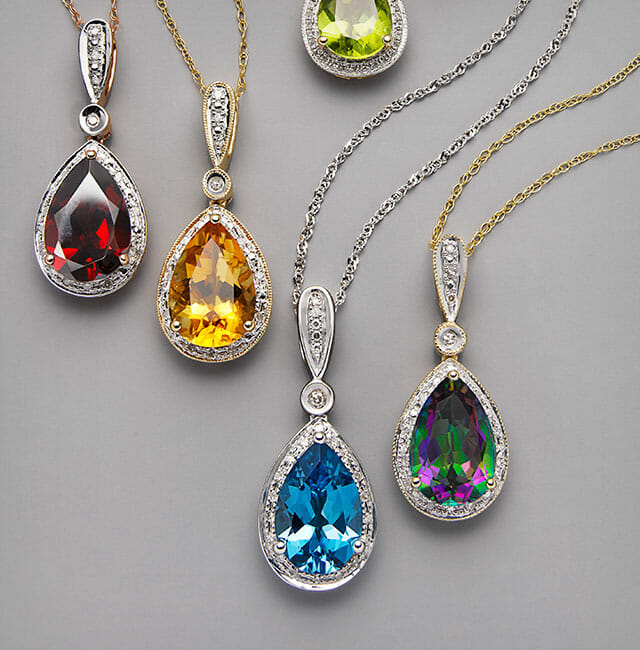
Image by Macy’s
Birthstones can be a wonderful way to show more of your personality through jewelry and other personal accessories. Jewelry designers can incorporate birthstones in so many ways. Let’s take a quick look at some of the more popular options:
- Large pendants: A favored way to incorporate birthstones into your life is in a large pendant. This style is very striking and offers a dramatic look that’s got flair and can complement the simplest outfit.
- Cage designs: Displaying birthstones in a cage is a fun thing to do. It means you get to carry a little piece of your most precious stone with you wherever you go. Typically, cage designs are used for necklaces or earrings.
- Bead strings: The possibilities are endless if you want to string birthstone beads into a strand or chain. With so many designs and patterns to choose from, it’s possible to create a truly personalized look.
- Held with prongs: When prongs are used, you can elevate or suspend birthstones and make them a focal point. Multiple birthstones can be included and made into necklaces, earrings, or rings.
- Set in metal: Setting birthstones into a base metal is a simple but sophisticated way to display them. It doesn’t detract from the piece as a whole and the stone can be the focus of the design. This option is suitable for pendants, earrings, and similar dangling items of jewelry.
Related: 5 Jewelry Trends You Must Adapt While Styling Yourself
Birthstones as Gifts: A Personal Touch
Birthstones are a great gift for a loved one, steeped with the individuality that’s so important if you want to choose a memorable gift. Each birthstone carries its own exquisite beauty and a deeply personal significance based on the recipient’s birth month.
Such thoughtful consideration displays a genuine understanding of the person’s individuality, making the gift more meaningful and heartfelt. Whether it’s the fiery ruby for July or the serene aquamarine for March, the chosen birthstone connects to the recipient’s identity and fosters a sense of cherished uniqueness.
This attention to detail transforms a simple gift into a symbol of affection and thoughtfulness, encapsulating emotions that words alone might struggle to convey.
The Enchanting World of Birthstones: FAQs
Q: Does every month have 3 birthstones?
A: The number of gemstones that represent a person’s birth month varies depending on the source. According to the Gemological Institute of America (GIA), there are multiple birthstones for some months, but not all have three.
Q: What are the three rarest birthstones?
A: While many birthstones are easily found, some are more elusive than others. The three rarest are alexandrite, known as the “emerald by day, ruby by night”, tanzanite, found exclusively in the foothills of Mount Kilimanjaro, and tourmaline, but in particular, the Paraiba tourmaline.
Q: What is the most powerful birthstone?
A: This is a very interesting question and one that’s difficult to answer. According to birthstone beliefs, a gemstone is the most potent when it’s that person’s birthstone. In other words, the most powerful birthstone is the one that belongs to your birth month or zodiac sign.
Q: What finger do you wear your birthstone on?
A: Birthstone rings are often worn on the right hand, differentiating them from engagement and wedding bands. In terms of the best finger, it’s whichever looks and feels best for you.
Q: Can I wear my birthstone every day?
A: Yes, you can wear your birthstone every day. They are a wonderful way to add a distinctive touch to your everyday look, have healing powers, and bring good luck to the wearer.
Conclusion
In conclusion, the world of birthstones by month unveils a captivating realm where beauty intertwines with personal and cultural significance. These gems aren’t merely symbols of one’s birth; they embody a connection to individuality and heritage.
The allure lies not only in their dazzling colors but also in the stories they carry—tales of ancient beliefs, modern desires, and timeless traditions. Gifting a birthstone is more than a gesture; it’s a recognition of someone’s unique journey and a nod to the traditions that have shaped us.
As we continue to cherish these gems, we honor both the rich tapestry of our past and the sparkle of the future.
References:

